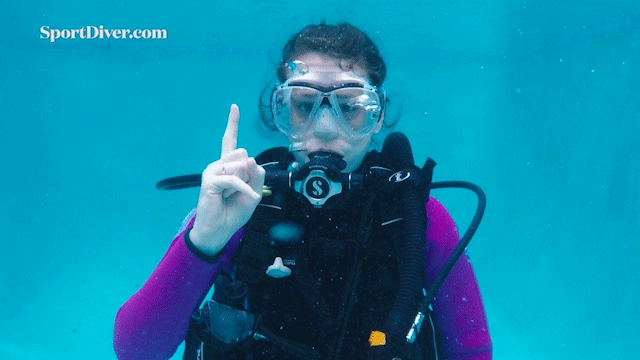Sign up for the daily CJR newsletter.
Scuba diving is a quiet sport, because, unless your facemask includes a transmitter, you simply can’t talk underwater. So divers use hand gestures.
It’s important to learn those to know what people are “saying.”
This one, for example, from Sport Diver magazine:
That means everything’s all right, right?
Wrong. In scuba talk, it means “ascend to the surface.”
The “thumbs-up” gesture is not, as popularly believed, derived from the ancient Roman gesture indicating that a gladiator should live. As Time magazine reported, that thumbs-up gesture meant disapproval, not approval. The thumb was a hostile symbol, “in the same way the middle finger was hostile, and it was a threat, just like it is now.”
The Oxford English Dictionary says the gesture was turned on its, er, head during World War I. In 1917, Arthur Guy Empey wrote a book, Over the Top, which also included Tommy’s Dictionary of the Trenches. (“Tommy” was “Tommy Atkins,” the book says, “The name England gives to an English soldier, even if his name is Willie Jones.”) “Thumbs up” was “Tommy’s expression which means ‘everything is fine with me.’”
But that gesture is not fine in some cultures. As Slate reported in 2003, thumbs up “traditionally translates as the foulest of Iraqi insults—the most straightforward interpretation is ‘Up yours, pal!’ The sign has a similarly pejorative meaning in parts of West Africa, Russia, Australia, Iran, Greece, and Sardinia, according to Roger E. Axtell’s book Gestures: The Do’s and Taboos of Body Language Around the World.”
So, then, what is the correct underwater sign for “everything is all right”?
Is that “okay,” “OK,” or “O.K.”?
It doesn’t matter. Underwater, you don’t have to spell.
But if you’re on the surface, you can spell it however you want, or according to your own stylebook. The OED lists those spellings as well as “o.k.,” “ok,” “okeh,” and “okey.” (Merriam-Webster lists only “OK,” with the “variants” “okay” and “ok”; Webster’s New World College Dictionary, the one used by many news organizations, offers “OK” or “O.K.”)
The Associated Press Stylebook wants you to use “OK.” The New York Times Manual of Style and Usage wants “O.K., not okay.” The Chicago Manual of Style uses “okay” in text but allows “OK” in manuscript markup and in its Q&A feature. Garner’s Modern English Usage is “okay” with “O.K.” and “OK,” too, noting, “okay is slightly more dressed up than OK.”
But where does it come from? As the OED says, “Competing theories as to the origin of the expression have been in evidence almost since its first appearance.” That was in 1840, the OED says, in The Lexington Intelligencer: “Perhaps no two letters have ever been made the initials of as many words as O.K… When first used they were said to mean Out of Kash, (cash;) more recently they have been made to stand for Oll Korrect, Oll Koming, Oll Konfirmed, &c. &c.”
M-W says the first usage as an adjective or adverb was 1839, the first as a noun in 1841, and the first as a verb in 1888. It says it is an “abbreviation of oll korrect, facetious alteration of all correct.”
Many sources trace that usage to Charles Gordon Greene in 1839 in The Boston Morning Post “In anticipation of your ‘huh?’” Mark Peters wrote in 2010, “you have to understand that abbreviations, especially humorous abbreviations, were in vogue in Boston at the time, kind of like our current world of LOL, ROTFL, and ZOMG.”
The real detective work was done by an etymologist named Allen Walker Read. He was profiled in The New Yorker in 1989 and before that, in 1945, when Read told the Modern Language Association that he had found the earliest uses of Pig Latin. Though he came to loathe that he was associated only with “OK” and not his other linguistic discoveries, Read spent much of his career finding first usages and then defending them. For years, for example, he traced the use of “OK” to 1840, as an abbreviation of “Old Kinderhook,” a slogan used by Martin Van Buren in his unsuccessful presidential reelection campaign. (Van Buren’s hometown was Kinderhook, New York.) Read eventually found the Greene 1839 reference, and went to his grave defending it.
And that could be the end of what Garner’s calls “the most successful Americanism ever—perhaps the best-known word on the planet.”
Except for that hand signal. If you put it below waist level, you might be playing the “Circle Game,” where, dictionary.com says, “If someone else makes eye contact with the circle, then the ‘circler’ gets to punch them in the arm.”
Then there is the “OK” sign that signals “white power.” Except that it didn’t. Until it did.
In 2017, posters on the alt-right discussion board 4chan decided it would be fun to “troll” liberals by claiming that the “OK” sign stood for “white power.” (If you squint, you might be able to see how the fingers and circle form the letters “W” and “P,” but a post by the Anti-Defamation League has a helpful illustration.) As The Chicago Tribune reported, “The idea was that ‘the libs’ would take up the cry that the OK symbol was racist and, in so doing, make themselves look ridiculous.”
But some right-wing activists and white supremacists started using the OK symbol as if it did mean white power, either because they weren’t in on the joke or because they wanted to turn the joke in on itself. Some say the symbol needs to be upside down, and some say the palm needs to face the signer, not the target.
As a result, as the Tribune report said, reactions have included, “the Chicago Cubs banning a fan for making the gesture behind a black TV reporter, and Oak Park River Forest High School announcing it would reprint more than 1,700 yearbooks at a cost of almost $54,000 because some students were displaying the hand sign.”
So, for now, using the “okay” symbol is complicated. Even underwater.
Maybe use the symbol for “shark” instead.
Has America ever needed a media defender more than now? Help us by joining CJR today.










